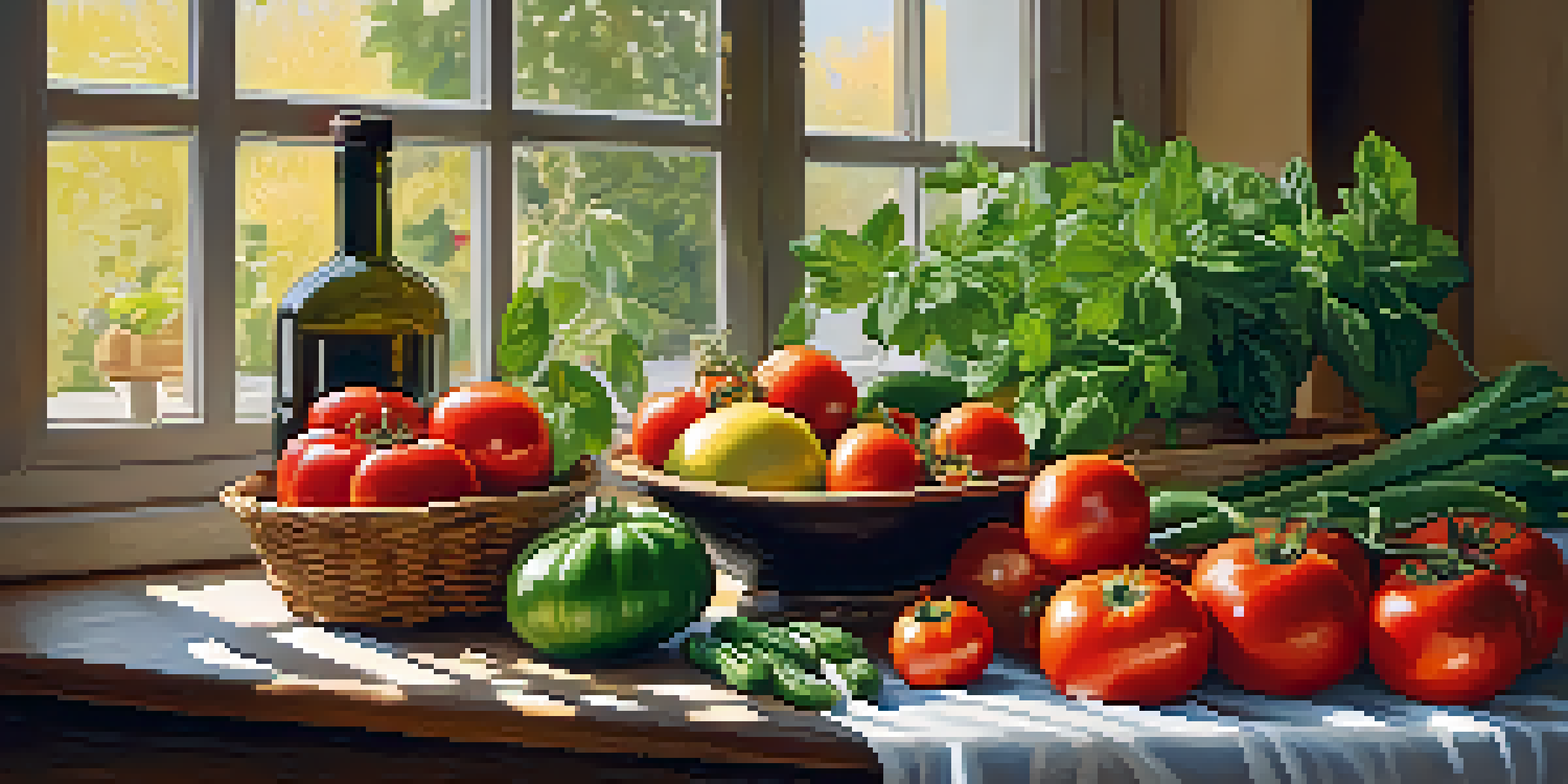The Art of Italian Vegetarian Cooking: Recipes and Heritage

Understanding the Roots of Italian Vegetarian Cuisine
Italian vegetarian cooking is deeply intertwined with the country's culture and history. The tradition of using fresh, seasonal ingredients stems from a time when families relied on their gardens and local markets. This connection to nature is evident in the vibrant flavors and colors found in Italian dishes, celebrating the simplicity of the ingredients.
Italian food is all about ingredients and the quality of those ingredients.
Many regions in Italy have their own unique vegetarian dishes, showcasing local produce and culinary traditions. For example, in Tuscany, you'll find hearty ribollita, a vegetable and bread soup that speaks to the heartiness of the land. Such regional specialties highlight how Italian cooking embraces diversity while focusing on plant-based ingredients.
This heritage not only preserves the flavors but also promotes sustainability, as it encourages the use of what is available and in season. As we dive deeper into the art of Italian vegetarian cooking, we’ll discover that the foundation is built on respect for ingredients, creativity, and a deep appreciation for communal meals.
Essential Ingredients for Italian Vegetarian Dishes
To master Italian vegetarian cooking, it's crucial to understand the key ingredients that define the cuisine. Olive oil, fresh herbs, tomatoes, and a variety of vegetables are staples that can elevate any dish. These ingredients not only add flavor but also reflect the essence of Mediterranean cooking, which values health and simplicity.

For instance, fresh basil and parsley can transform a simple pasta dish into something extraordinary. The quality of the olive oil can also make a significant difference, as a good extra virgin olive oil brings richness and depth to salads and sauces. Understanding how to select and use these ingredients is fundamental for any aspiring cook.
Italian Cuisine Values Freshness
Italian vegetarian cooking emphasizes fresh, seasonal ingredients that reflect the country's rich cultural heritage.
Additionally, incorporating legumes, grains, and cheeses like ricotta or Parmigiano-Reggiano can create satisfying, nutritious meals. These elements not only enhance the flavor profile but also provide essential nutrients, making Italian vegetarian cooking both delicious and wholesome.
Classic Italian Vegetarian Appetizers to Start Your Meal
No Italian meal is complete without a few delicious appetizers, and vegetarian options shine brilliantly in this category. Dishes like bruschetta topped with fresh tomatoes, garlic, and basil showcase the beauty of simple ingredients. This classic starter sets the tone for a delightful dining experience.
The best way to enjoy food is to share it with others.
Another timeless appetizer is caprese salad, featuring ripe tomatoes, fresh mozzarella, and a drizzle of balsamic vinegar. It’s a perfect example of how a few quality ingredients can come together to create something truly special. These appetizers not only tantalize the taste buds but also highlight the vibrant colors and flavors of Italian cuisine.
Exploring options like stuffed zucchini blossoms or marinated artichokes can further expand your appetizer repertoire. Each dish tells a story, inviting diners to savor the flavors of Italy before diving into the main course.
Hearty Italian Vegetarian Main Courses to Savor
When it comes to main courses, Italian vegetarian cooking offers a plethora of satisfying options. Dishes like eggplant parmesan or mushroom risotto are not only filling but they also showcase the rich flavors of Italian cuisine. These meals provide comfort while celebrating the beauty of plant-based ingredients.
Pasta dishes, such as spaghetti aglio e olio or pesto linguine, are also popular choices that can be easily made vegetarian. The versatility of pasta allows for endless creativity, whether you’re adding seasonal vegetables or a medley of herbs. This adaptability makes Italian cooking accessible and enjoyable for everyone.
Regional Dishes Showcase Diversity
Various regions in Italy offer unique vegetarian dishes, highlighting local produce and culinary traditions.
Additionally, options like polenta with sautéed greens or vegetable lasagna highlight the comforting nature of Italian meals. Each dish invites friends and family to gather around the table, fostering a sense of community and shared experience.
Delicious Italian Vegetarian Sides to Complement Your Meal
Sides play a vital role in Italian vegetarian cooking, providing the perfect complement to main dishes. Roasted vegetables drizzled with olive oil and herbs not only add flavor but also a colorful presentation. Seasonal ingredients shine in these sides, making them an integral part of any meal.
Another popular side is polenta, which can be served creamy or grilled, adding a satisfying texture. It pairs well with a variety of dishes and can be flavored with cheese or herbs for an extra kick. This versatility makes it a beloved staple in Italian kitchens.
Don’t overlook classic Italian salads, such as panzanella, which brings stale bread and ripe tomatoes together for a refreshing dish. These sides enhance the overall dining experience while celebrating the art of using fresh, simple ingredients.
Sweet Italian Vegetarian Desserts to Indulge In
Desserts are the perfect way to end an Italian meal, and there are many vegetarian options that satisfy any sweet tooth. Classic treats like panna cotta, a creamy custard, or tiramisu, layered with coffee-soaked ladyfingers, showcase the finesse of Italian dessert-making. These indulgent options are sure to leave a lasting impression.
Fruits play a significant role in Italian desserts as well. A simple bowl of macerated berries or a fresh fruit tart celebrates the natural sweetness of seasonal produce. These lighter options can be a delightful way to balance a rich meal, emphasizing the importance of using fresh ingredients.
Community is Central to Meals
Italian meals are often communal experiences that celebrate tradition, family, and the joy of sharing food.
Additionally, desserts like cannoli, filled with sweet ricotta and often garnished with chocolate chips, offer a delightful crunch and creaminess. Each dessert tells a story, reflecting the region's flavors while providing a sweet ending to a memorable meal.
Celebrating the Tradition of Italian Vegetarian Cooking
The art of Italian vegetarian cooking is not just about the food; it’s a celebration of tradition, family, and community. Meals are often a communal experience, where families gather to enjoy homemade dishes that have been passed down through generations. This sense of togetherness is a hallmark of Italian culture.
As we embrace Italian vegetarian cooking, we honor the heritage that emphasizes respect for ingredients and the joy of sharing. Each recipe has a story, connecting us to the past and the people who have cooked these meals before us. It's about creating memories around the table, fostering relationships through food.

By exploring these recipes and traditions, we can continue to celebrate and preserve the rich culinary heritage of Italy. Whether you're a seasoned cook or just starting, there's always something new to learn and share in the world of Italian vegetarian cuisine.